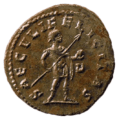Pilum facts for kids
The pilum was a special type of spear used by the Roman army a very long time ago. Roman soldiers would throw these spears at their enemies before fighting them up close. A pilum was usually about 2 meters (6.5 feet) long. It had a long wooden handle and a strong iron tip. This iron tip was about 60 centimeters (2 feet) long and about 7 millimeters (a quarter-inch) thick. The tip ended in a sharp, pyramid-shaped point. The iron part was connected to the wooden handle in one of two ways: either it fit into a hole (a socket) or it had a flat piece (a tang) that was hammered into the wood.
Contents
What Was the Pilum For?
The pilum was designed to be thrown from a distance, usually about 15 to 30 meters (50 to 100 feet). Roman soldiers would throw a volley of these spears just before they charged into battle. This would break up enemy formations and make it harder for them to fight.
How Did the Pilum Work?
The pilum was very effective because of its design. When it hit an enemy shield, the long, thin iron tip would often bend. This made it impossible for the enemy to pull the pilum out of their shield and throw it back. It also made the shield very heavy and hard to use, forcing the enemy to drop it. This left them unprotected.
If the pilum hit an enemy soldier, the sharp tip could cause serious injury. The weight of the iron tip also meant it could punch through armor or shields.
Different Kinds of Pila
Over time, the pilum changed a bit. Early versions might have been lighter, while later ones were heavier and stronger. Some pila had a small lead ball added to the shaft to give them more weight and make them fly further and hit harder.
Why Was the Pilum So Important?
The pilum was a key weapon for the Roman legionaries (soldiers). It gave them a big advantage in battles. By throwing their pila, they could weaken the enemy before the main fight even began. This clever design helped the Roman army become one of the most powerful forces in the ancient world.
Images for kids
-
Reconstruction of a post-Marian pilum
See also
 In Spanish: Pilum para niños
In Spanish: Pilum para niños






